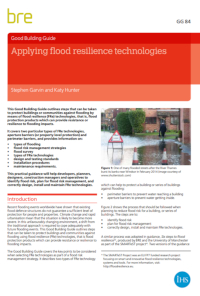Applying flood resilience technologies GG 84
Applying flood resilience technologies (GG 84) was written by Stephen Garvin and Katy Hunter, and published by BRE on 8 September 2014. BRE (Building Research Establishment) is an independent, research-based consultancy, testing and training organisation, operating in the built environment and associated industries.
Recent flooding events worldwide have shown that existing flood defence structures do not guarantee a sufficient level of protection for people and properties. Climate change and rapid urbanisation mean that the situation is likely to become more severe. In this unfavourably changing environment, a shift from the traditional approach is required to cope adequately with future flooding events.
This 12-page Good Building Guide outlines steps that can be taken to protect buildings or communities from flooding through the use of flood resilience (FRe) technologies, that is, flood protection products which can provide resistance or resilience to flooding impacts.
It covers two types of FRe technologies:
It provides information on:
- Types of flooding.
- Flood risk management strategies.
- Flood survey.
- Types of FRe technologies.
- Design and testing standards.
- Installation procedures.
- Maintenance requirements.
This practical guidance will help developers, planners, designers, construction managers and operatives to identify flood risk, plan for flood risk management, and correctly design, install and maintain FRe technologies.
Its contents are:
- Introduction.
- Flood risk.
- Types of flooding.
- Flood risk management strategy.
- Survey.
- Types of FRe technologies.
- Relevant design and testing standards.
- Installation.
- Maintenance.
- References.
- Further reading and information.
[edit] Related articles on Designing Buildings Wiki
- BRE articles on Designing Buildings Wiki.
- BRE Buzz articles on Designing Buildings Wiki.
- BS 851188.
- Building flood resilience.
- Building Research Establishment.
- Catchment flood management plans.
- Flood.
- Flood defences.
- Flood insurance.
- Flood risk management plans.
- Flood risk.
- Future flood prevention.
- Pitt Review.
- Thames barrier.
- Water engineering.
Featured articles and news
Infrastructure that connect the physical and digital domains.
Harnessing robotics and AI in challenging environments
The key to nuclear decommissioning and fusion engineering.
BSRIA announces Lisa Ashworth as new CEO
Tasked with furthering BSRIA’s impressive growth ambitions.
Public buildings get half a million energy efficiency boost
£557 million to switch to cleaner heating and save on energy.
CIOB launches pre-election manifesto
Outlining potential future policies for the next government.
Grenfell Tower Inquiry announcement
Phase 2 hearings come to a close and the final report due in September.
Progress from Parts L, F and O: A whitepaper, one year on.
A replicated study to understand the opinion of practitioners.
ECA announces new president 2024
Electrical engineer and business leader Stuart Smith.
A distinct type of countryside that should be celebrated.
Should Part O be extended to existing buildings?
EAC brands heatwave adaptation a missed opportunity.
Definition of Statutory in workplace and facilities management
Established by IWFM, BESA, CIBSE and BSRIA.
Tackling the transition from traditional heating systems
59% lack the necessary information and confidence to switch.
The general election and the construction industry
As PM, Rishi Sunak announces July 4 date for an election.
Eco apprenticeships continue help grow green workforce
A year after being recognised at the King's coronation.
Permitted development rights for agricultural buildings
The changes coming into effect as of May 21, 2024.























